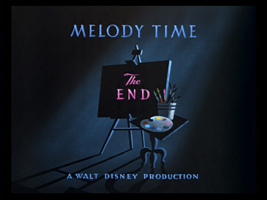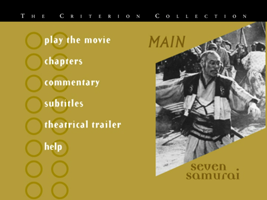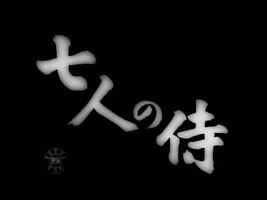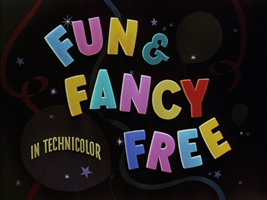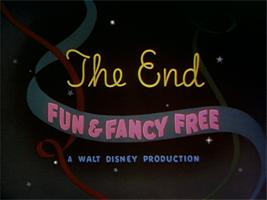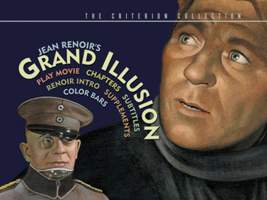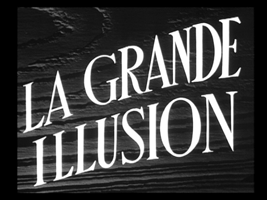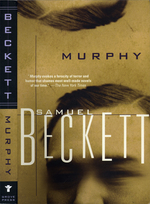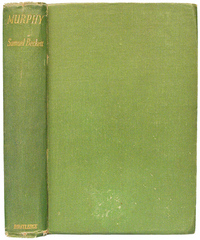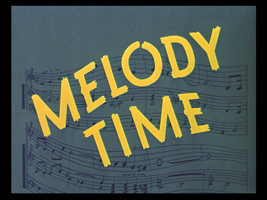
BETH That was the best of the “package” films.
BROOM I agree. I think that was significantly superior to the last two.
ADAM Well, it wasn’t better than The Three Caballeros.
BROOM The last two: it was better than Make Mine Music or Fun and Fancy Free.
ADAM That is true. It was slicker and more orderly than The Three Caballeros, but Three Caballeros had an anarchic glee that I enjoy.
BROOM The Three Caballeros is probably more fun overall, but I thought this was an encouraging improvement on both the story and technical fronts.
BETH Mostly technical.
ADAM Yes, the stories were still pretty indifferent.
BROOM They were dippy but there was better timing. There was just a real dead dumbness to Bongo that was depressing, and we’re moving in the right direction from there. I’m not saying that this was great.
ADAM We should say, before we move on, that Beth had been dreading this screening.
BROOM She dreads them all. She’s been dreading all of the 40s movies.
BETH Yes, I have. I want to get to something good.
BROOM I really enjoyed this one, especially because I had no expectations for it. I found myself feeling really pleased that it had some verve and panache. In places.
ADAM In places.
BETH I really expected it to be terrible, so it was nice to see some pretty backgrounds and fun animation.
ADAM But let’s be clear: it wasn’t actually good.
BETH No, it wasn’t good.
BROOM But it was superior to Make Mine Music, which it was essentially a continuation of. Short for short, almost all of them were better than the average of Make Mine Music. Maybe. Let’s talk about them and see if that’s true.
BETH It’s true.
1. ONCE UPON A WINTERTIME
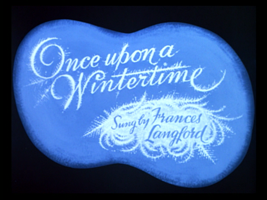
ADAM If you’re curious where I had seen that before…
BROOM Oh, very curious.
ADAM … one of the things we had taped off of the Disney Channel freebie hour was a Valentine’s Day special.
BETH It does seem very Valentine’s-y.
BROOM It was like a greeting card.
ADAM I don’t know if I saw them spiral onto the ice, but I definitely saw the part where the bunnies make the interlocked hearts with their butts.
BROOM A lot of the action was dumb and was rehashing either Bambi or the short On Ice. The thing with ice breaking and going over a waterfall was played out, even by then. It wasn’t very creative on that front. But visually I thought it was very impressive.
ADAM The backgrounds had a stylish two-dimensionality to them, which was attractive.
BETH And the colors used were very unusual and effective.
BROOM Since this subject is probably the richest source of discussion for the movie, I’m just going to go into it a little bit deeper. Part of the depressing quality of the last two movies, and overall of the 40s movies, comes from the fact that the lush storybook quality of the first few movies was no longer suited to the period, but they hadn’t yet really found anything new to do. Mickey and the Beanstalk, design-wise, didn’t have any new place to go, but it didn’t believe in what they used to do. It was between styles and so had no style. It was like they were going through the motions of doing an earlier style that they clearly felt was dated, because they didn’t have any new way of doing things. I think in this movie we saw them finding something new.
ADAM It has a late-Matisse feel, like early pop art.
BETH Yes, it’s the beginning of that great flat style of animation.
BROOM The Mary Blair look. I think that Mary Blair had a hand in some of those background designs, especially in “Once upon a Wintertime.”
ADAM Of course we did see this sort of thing in “Pink Elephants on Parade.”
BROOM That’s slightly different. There’s phantasmagoria and then there’s this stylized surrealist design.
ADAM Well, they’re still thinking of it in keeping with the phantasmagoric style, if you will. That was what “Bumble Boogie” was. They have this tradition of abstract craziness…
BROOM Yes, that’s a mode they have and I’m happy they’re keeping it around, but I think that what we saw in the backgrounds of “Wintertime” was something new, a new sense of design.
ADAM Yes, it was a marriage of the flatness with more-or-less realism.
BROOM I felt like the only precursor to that kind of design was in Bambi, when things occasionally became stylized and angular and they would make very strong color choices.
ADAM But you talked at one point about a scene with a black backdrop with pink and yellow on it, do you remember that? In one of the earlier movies.
BROOM You’re right, the best thing we’ve seen in that style so far was that train scene in The Three Caballeros, which was also by Mary Blair.
BETH Yes, that was great, that black background with bright colors.
BROOM They were really embracing that here. In Make Mine Music, I suppose that one that you guys really hated, that lonely window one, sort of touched on it, but they didn’t seem to know what to do with it. This movie really seized it. And I think by Alice in Wonderland we’ll see them knowing what to do in the foreground to make the most of it.
BETH Here they seemed more excited about the background than they did about the foreground.
BROOM But I think even the animation, and not just the design, also had more kick to it in this movie.
BETH The character designs I didn’t like.
BROOM I guess if we’re just talking about the first segment, I agree.
ADAM It was sort of strange to have those contemporary-looking backdrops with the old-timey people figure-skating.
BROOM But I think that kind of juxtaposition is something they explored quite a bit; I think of that as a particular Disney feeling. I’m not sure but I think we may see a more refined version of that in the next movie, in “The Legend of Sleepy Hollow.”
BETH I feel like we talked enough about that one.
2. BUMBLE BOOGIE
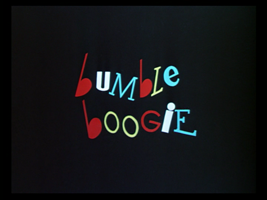
BROOM I thought that was awesome. I totally enjoyed that.
BETH It was right up your alley.
ADAM Albeit very similar to a number of things we’ve seen.
BROOM It was most similar to “After You’ve Gone” from Make Mine Music.
ADAM Was that the thing with the instruments?
BROOM Yes.
ADAM They really love this idea that they’re marrying music and animation.
BROOM I thought this was one of their strongest efforts at that since Fantasia. The sync was very satisfying and the atmosphere was fun.
ADAM It was psychologically satisfying, and sort of creepy. That giant snake-caterpillar thing made out of piano keys.
BROOM And the rate at which you were bombarded with new, strong images was satisfyingly high. It was very enjoyable, and it made me sit up and think, “we’re seeing something good again!”
ADAM I agree with that. What did you think of it as an adaptation of Rimsky-Korsakov?
BROOM It’s just a thing that was done in those days, to take a classical piece and boogie it up. It was a pretty rudimentary boogie-ization, but it was fine, and the choice of piece handed them the bumblebee as a character. I thought it was a little odd that when the flowers were scary to him, he got his revenge by boxing the flowers and destroying them. They didn’t really follow through on the concept of what a bee actually does with flowers.
3. THE LEGEND OF JOHNNY APPLESEED
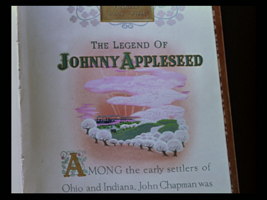
ADAM This was the dreckiest of the segments.
BROOM It was undistinguished. But if you think of it as the descendant of, say, “Casey at the Bat” or “Peter and the Wolf,” it was better animated than those. It wasn’t quite as strong as “Once upon a Wintertime” but it still had some nice design in the backgrounds. It had good atmosphere, a nice autumnal Americana.
ADAM I thought the cornpone Parson Weems quality of it was disturbing.
BROOM Why? That’s what it was.
ADAM Why? Because that’s what’s going to make John McCain president.
BROOM Well, right now may not be the best time in history for us to be thinking about these things, but I think there’s room in life for Norman Rockwellisms, and it’s okay to indulge them sometimes. I thought that Johnny Appleseed was pretty gay, and it made you feel like, “I guess it’s good that we have apple trees, but nobody should want to be like that guy.”
BETH Here’s my problem with this movie as a whole: none of the characters – except for the chipmunk – seem like Disney characters. There were no characteristics of their faces or their bodies that reminded me of classic Disney. They weren’t like Bambi or Dumbo.
BROOM Can you characterize that? Is it a warmth of characterization that they were lacking?
BETH Well, the bodies of the animals – like the bunnies in “Wintertime” – they were husky in a strange way. They didn’t seem as lithe, as nimble, as animals usually do in Disney. And their faces seemed dumber.
BROOM That’s definitely how I’ve felt about a lot of characters we’ve seen in the past few movies. I feel like they’re on their way out of that here, but they still have that look.
ADAM The bunnies in the first segment here were cut-rate.
BETH Johnny Appleseed had this weird, not-quite-characterized face.
ADAM He started out as a bubble-nosed young man – he looked basically identical to the young man in “Once upon a Wintertime.” And not that different from Pecos Bill or Little Toot, frankly.
BROOM It’s a tough job, though. Let’s ask ourselves: have they at any point, all the way back to Snow White, created a semi-realistic human character to our satisfaction? I think they just haven’t solved that problem yet.
ADAM Slue Foot Sue looked a lot like what Cinderella’s going to look like, a couple movies from now.
BROOM I think we’re going to find Cinderella herself to be quite bland. I don’t think that’s the solution either. If you picture the man from 101 Dalmatians – that’s a good solution to making a cartoon person. He’s very gangly and has a very strong cartoony characterization but he’s also a person. He’s nicely in-between. I think that this blandness was just the best they had come up with. Remember Geppetto being so blobby?
BETH I think they tried to make Johnny Appleseed look a little different, and it just didn’t quite work. He looked creepy to me.
ADAM He grew up from being just “a young Disney man” to being like “The Martins and the Coys.” The same way that Pecos Bill looked just like “Casey at the Bat.” They’ve only got like six types.
BROOM And are any of them human enough to really relate to?
ADAM I’ll bet it seems worse to us having watched them all in a row, because we can recognize them as stock characters.
BROOM I recognize what Beth is saying as a basic reaction: “I don’t relate to that character. I understand what the character represents, but I don’t feel like I’m in the company of a person.”
BETH I’m saying that they don’t feel like the Disney characters that were established in the late-30s, early-40s. They don’t have that look, and they don’t have the 50s look. They have an uncertain look.
BROOM Just a pale face with some features stuck on it.
BETH Just uninspired. They care more about the backgrounds than the people.
BROOM There’s an impersonality to a lot of these. And I think that’s why my favorite ones are the ones that have to do with music and splashes and lights. Fireworks displays instead of stories. Okay, so the “Johnny Appleseed” one was a little disappointing.
ADAM Also weirdly Christian.
BROOM Yes. All that emphasis on the bible, and the song about “my lord.” I was surprised.
ADAM It comes up also in “Trees.”
BROOM Is this the first explicit Christianity in any of these? Previously he seemed to avoid it – every time things went in that direction, it would just be a castle in the sky, or trees curved like the arch of a church. But never a crucifix and god and a bible with a cross on it. I was surprised. Anything to say about Johnny Appleseed’s dramatic death in the course of the cartoon? I thought that was surprising.
ADAM I thought that was surprising too. It would have upset me as a child.
BROOM “That’s just your husk, John.”
BETH “That’s just your husk” is an upsetting thing to hear.
BROOM And yes, that chipmunk did seem to be either Chip or Dale. And the red Indians? Comments?
ADAM It was historically inaccurate.
BETH It was the time.
4. LITTLE TOOT
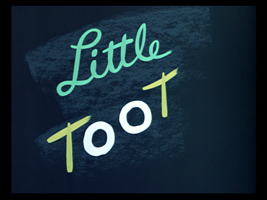
ADAM I thought it was pretty adorable, in spite of myself.
BETH I enjoyed “Little Toot.”
BROOM I thought the effects animation, and other features of the animation, were very impressive. He was rounded and shaded in complex ways the whole time.
ADAM His dad was actually a pretty well-designed character; you saw a family resemblance but also a stern, proudly working-class quality. He seemed like an individual.
BROOM He’s not a person, he’s a tugboat. They’re okay with things and animals, I think we’re saying.
BETH I thought the characterization of those tugboats was better than any of the animals or people in this movie.
BROOM Those buoys with angry faces and claws made of water were quite scary.
BETH That scene was scary! And that chanting…
BROOM “… bad boy! …”
ADAM “… shame! …”
BROOM And then they sang “Do or die!” There was an intensity to “Little Toot” that surprised us all.
ADAM It beat the pants off of what happened to Pedro the mail plane.
BROOM It was reminiscent of Pedro the mail plane, but in “Pedro,” there was a wink in the narrator’s voice the whole time. This one, even though it was the Andrews Sisters, was more intense.
BETH This was also easier to relate to because it happened in the city rather than some remote place where only an airplane can fly.
BROOM It was within sight of the New York skyline that I see every day. The terrible, terrible catastrophe that Little Toot causes was out of proportion to your expectations.
ADAM That was like a Cloverfield level of violence.
BROOM It was Speed 2. Thousands of deaths, surely.
BETH He didn’t mean to. He didn’t know. He just should have figured it out sooner.
BROOM Anyway, “Little Toot” was pretty good.
5. TREES
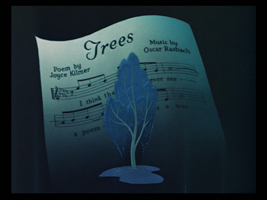
ADAM This was the campiest thing I think we’ve seen in any Disney film. Certainly in the top three campiest moments.
BROOM There were interesting things in the look of it; when the wind was blowing in the trees and their shapes were strange and elongated, I thought that was neat. But it was not a good of visualization of the poem and the whole concept was just kitsch.
ADAM It was pious and weird.
BROOM Again, I think that their draftsmanship has improved significantly since the last couple of movies, and you could see it watching those leaves blowing around. They can’t help themselves but draw those – we saw those leaves blowing in the wind in Fantasia, in Bambi, and again in Make Mine Music, and we might even have seen it in Fun and Fancy Free. And then we saw them again here. But they were better here than they’ve been recently. In fact I thought it was very cool when the scene of the tree and the sunset becomes the smear of colors on another leaf blowing away. There were nice effects in this segment, but they just sort of flew past and we didn’t notice them because the piece itself was stupid.
ADAM Joyce Kilmer. Man. I think my brother performed “Trees” at the poetry festival in second grade. It’s a terrible poem.
BROOM So “only God can make a tree” – there’s no actual reference there to the “tree” on which the Lord Jesus was crucified.
ADAM Lord Jesus was not crucified on a tree!
BROOM “On crosstree” – that term is in Ulysses. [ed. It’s a nautical term]
ADAM There’s no reference to the cross in the poem.
BROOM Well, I don’t know about the poem, but it seemed like the Disney studios, whom I’ve never known to go Christian when they don’t need to, went Christian at the end of that segment. The tree turned into a cross with a halo around it.
BETH It wasn’t the cross of the crucifixion.
BROOM It wasn’t?
BETH I mean, I guess any cross is that cross, but I don’t think it was meant that way.
ADAM I agree. It was just a throwaway.
BROOM You think it was just a God-signifier?
ADAM Yeah – “let’s throw in some Christian appeal.”
BETH Anyway, “Trees” was no good.
ADAM “Trees” was the worst.
BROOM I thought that, for bad kitsch, it was better than the one in Make Mine Music that you guys also didn’t like. It had more going on visually. But yes.
6. BLAME IT ON THE SAMBA
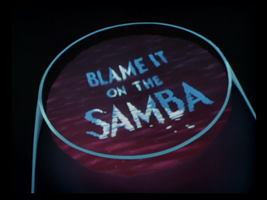
BROOM A little bit sad that that was the showing for Jose Carioca. I had high hopes for his reappearance, but he didn’t say anything. Donald didn’t say anything either.
BETH It was colorful. I enjoyed it.
ADAM Ethel Smith was no Aurora Miranda.
BROOM I thought it was cool that this Tex Avery mayhem threatens a real live human. It had sort of a Roger Rabbit quality – the Aracuan bird is going to blow up the actual Ethel Smith? But she seemed to be okay.
ADAM She was not a very good actor. She didn’t convincingly interact with Donald or Jose Carioca.
BROOM Well, when she was on fire, it wouldn’t have been appropriate to the tone for her to look like she was actually on fire. I think her mock-surprised look was exactly right. I really enjoyed when they were blue and then listening to the music cheered them up and gave them their proper colors. I enjoyed that fairly sincerely.
BETH You did? Even though you knew that was exactly what would happen?
BROOM I’m not saying it surprised me. It was just a nice visual. That when you’re in a bad mood, the sound of the cabasa can put the red into you and then the purple, and then you’ll shine because you’re happy again. I also liked that the segment wasn’t just a callback to the characters, but was specifically a callback to The Three Caballeros in that they were walking into a pop-up book restaurant. But the song wasn’t as good. It wasn’t as good as the music from Three Caballeros.
BETH No, but it was still fun.
7. PECOS BILL
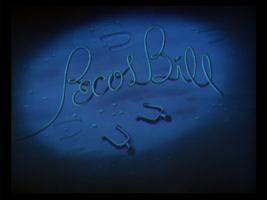
BROOM This had the pre-Roy Rogers segment, the Roy Rogers segment, and then the story of Pecos Bill.
ADAM It was much too long.
BROOM Obviously the part with Pecos Bill being wild was the fun part, and they took ten minutes to get there. They warned us they were going to be slow about it, but that still doesn’t make it fun, especially at the end of the movie.
ADAM My favorite thing in the whole movie was when the state of Texas fills up the entire continent, including the peninsula of Florida, so Florida has to grow its own subsidiary peninsula.
BETH I thought that was funny too.
BROOM I was interested in the fact that Sue was…
ADAM …brutally dispatched?
BROOM No, not the story. That when she arrived, she was basically showing it all. She was wearing little white panties, but her dress flew all the way up so you could see them. She was riding a catfish down the river. She was a pin-up drawing that they put in the cartoon. That’s something that they wouldn’t venture again until the 90s.
BETH Do they do that now?
BROOM Well, they don’t exactly do that…
ADAM But the female characters are much sexier now.
BROOM The pin-up drawings that the animators do in their spare time have gotten much closer to being in the movies these days. And that’s clearly what Sue was, with a little demure face put on her. I was a little surprised to see that. It was also a little creepy to see her pretty face kissing the googly cartoon face of Pecos Bill. He wasn’t the male equivalent.
ADAM It was weird that the horse murdered her.
BROOM Yes. It was weird that Pecos Bill sucked at the teat of a coyote just off screen.
ADAM It was weird that he kissed the horse on the lips. Much of the psycho-sexual quality of this short was disturbing. And I thought it was fairly misogynistic. She’s killed because of her bustle? What a terrible terrible thing.
BROOM What was the rhyming line? “It put the classy on her chassis?”
BETH Something like that. “It was quite classy and it completed her chassis,” or something.
ADAM It just goes to show that they can’t abide a strong woman.
BROOM And when they first mention her, Bobby Driscoll groans, “A woman in the story?”
ADAM The interaction of the live action and the animation was not very successful.
BROOM They didn’t even try. I really liked those little quails running through the desert with the long shadows. I know, it was the same quails from Bambi and several other places.
BETH They really love doing that.
BROOM I liked the atmosphere of that, with that weird music playing, and them running through the desert with those long shadows. I know you guys were saying “get this over with” at that point, but I thought it looked cool, and I thought the pencil-drawn tumbleweed effect was a cool, smart choice.
ADAM I liked that. I also liked when Trigger participated in the storytelling.
BROOM I’m not ready to say I liked that.
ADAM That was a staple of popular culture, right?
BROOM Roy Rogers and Trigger? I think so. They were the absolute first billing in this movie, before the title.
ADAM And who was the female counterpart? Dale Evans?
BROOM Yes, but she wasn’t here. But Luana Patten was back.
ADAM I’m glad to know she escaped that party.
BROOM And this party.
ADAM Yes, instead she became apprentice to this harem of sexless cowboys.
BETH She was kidnapped.
BROOM She got out of that house somehow but just ended up in the desert, where these men were happy to entertain her with more creepy stories in the middle of the night. But Bobby Driscoll was there with her this time. The two of them were the kids from Song of the South, and, as Leonard Maltin said in one of those countless Leonard Maltin featurettes, Disney was trying to cultivate a stock company of performers. By bringing back Luana Patten over and over he’s trying to work on the brand. “If you see a Disney movie, you’re going to see that cute little girl!”
ADAM She was the Dakota Fanning of her day.
BROOM Well, she was the Dakota Fanning of these two movies. And of Song of the South and of that other companion movie to Song of the South [ed.: So Dear to My Heart]. Anything to say about the interstitials, or the singing mask at the beginning?
ADAM I thought that the paintbrush theme was not that successful.
BROOM Even that I thought was nicer than Make Mine Music.
ADAM We all agree that Make Mine Music was the nadir.
BROOM I think Fun and Fancy Free was the nadir.
ADAM Oh. I get them confused.
BROOM We’re clearly coming out of the woods. Things are going to be better. I feel it.
[we read the New York Times review]
ADAM I think that Bosley Crowther is getting archer as he ages.
BROOM I think Bosley Crowther is pretty good, based on these.
ADAM He must have been gay. [ed. I don’t think so!] I’m picturing him as being like the second Mr. Wilson on “Dennis the Menace.” [ed. this guy?] He looked like he should be in a smoking jacket.
BROOM Every time, Bosley Crowther says exactly something I’ve already said, and I feel vindicated. But I don’t agree with him that the Johnny Appleseed songs were catchy. I thought they were pretty bad. Okay, next time: The Adventures of Ichabod and Mr. Toad.
ADAM We’re coming out of the tailspin, Beth.
